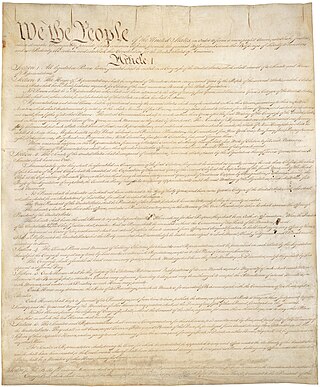Top Qs
Timeline
Chat
Perspective
Constitutionalism in the United States
Belief that the U.S. Constitution limits the powers of government to protect civil liberties From Wikipedia, the free encyclopedia
Remove ads
Constitutionalism in the United States is the framework of principles and practices that uphold the United States Constitution as the supreme law of the land, guiding governance and protecting individual rights.[1] It emphasizes the rule of law, separation of powers, checks and balances, judicial review, and federalism, rooted in Enlightenment ideals of liberty and governance by consent.[2] Since its ratification in 1788, the Constitution has shaped American political, legal, and cultural development.

Remove ads
Historical background
Origins and influences
The U.S. Constitution, drafted in 1787 at the Constitutional Convention in Philadelphia, addressed the weaknesses of the Articles of Confederation, which lacked a strong central government.[3] Influenced by Enlightenment thinkers like John Locke and Montesquieu, as well as British legal traditions such as the Magna Carta (1215) and the English Bill of Rights (1689), the framers sought to balance power and liberty.[4] The Constitution established a federal system and a tripartite government with legislative, executive, and judicial branches.[5]
The Bill of Rights, ratified in 1791, added the first ten amendments to protect individual liberties, including freedom of speech, freedom of religion, and freedom of the press.[6]
Ratification and early debates
Ratification sparked debate between Federalists, who favored a strong central government, and Anti-Federalists, who feared centralized power and demanded explicit rights protections.[7] The Federalist Papers, authored by Alexander Hamilton, James Madison, and John Jay, defended constitutionalism, emphasizing checks and balances to prevent tyranny.[8]
Remove ads
Core principles
Summarize
Perspective
Rule of law
The Constitution is the supreme legal authority, binding all government branches and citizens.[9] This ensures fairness and predictability in governance.
Separation of powers
The Constitution divides government into three branches: - Legislative: Congress, responsible for lawmaking (Article I). - Executive: The President, tasked with enforcing laws (Article II). - Judicial: The Supreme Court and federal courts, which interpret laws (Article III).[4]
Each branch operates independently to prevent dominance.[10]
Checks and balances
Each branch can limit the others, such as Congress overriding presidential vetoes or the judiciary declaring laws unconstitutional.[9]
Judicial review
Established in Marbury v. Madison (1803), judicial review allows courts to invalidate unconstitutional laws or actions.[11] Chief Justice John Marshall solidified the judiciary’s role as a constitutional guardian.[12]
Federalism
The Tenth Amendment reserves powers not delegated to the federal government for states or the people, fostering local governance.[13]
Individual rights
The Bill of Rights and amendments like the Fourteenth Amendment protect freedoms and ensure equal protection.[7]
Remove ads
Constitutional interpretation
Originalism vs. living constitutionalism
Debates over interpretation shape constitutionalism: - Originalism: Interprets the Constitution based on its original meaning, as advocated by Justice Antonin Scalia.[14] - Living constitutionalism: Views the Constitution as adapting to modern needs, championed by Justice William J. Brennan Jr..[15]
These approaches influence rulings like District of Columbia v. Heller (2008) on gun rights and Obergefell v. Hodges (2015) on marriage equality.[16][17]
Landmark cases
Key decisions include: - McCulloch v. Maryland (1819): Upheld federal supremacy.[18] - Brown v. Board of Education (1954): Ended racial segregation.[19] - Dobbs v. Jackson Women's Health Organization (2022): Overturned Roe v. Wade, shifting abortion rights to states.[20]
Contemporary issues
Security vs. liberty
Post-9/11, policies like the USA PATRIOT Act raised concerns about surveillance and due process.[21]
Federalism disputes
Issues like healthcare (National Federation of Independent Business v. Sebelius, 2012) highlight federal-state tensions.[22]
Judicial independence
Politicized judicial appointments spark concerns about impartiality.[23]
Amending the Constitution
The amendment process is rigorous, with only 27 amendments ratified.[4] The Equal Rights Amendment remains unadopted.[24]
Remove ads
Global influence
U.S. constitutionalism has influenced global constitutions, particularly in federal systems and bills of rights, though its rigid amendment process is distinctive.[25]
See also
- United States constitutional law - Constitutional convention (political custom) - Constitutional crisis
- Alliance Defending Freedom
- American Civil Liberties Union
- Center for Constitutional Rights
- Constitutional militia movement
- Drug Policy Alliance
- Electronic Frontier Foundation
- National Coalition Against Censorship
- National Rifle Association
- New York Civil Liberties Union
- Rutherford Institute
- United States Bill of Rights
Remove ads
References
External links
Wikiwand - on
Seamless Wikipedia browsing. On steroids.
Remove ads
